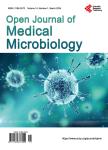Quantitative Detection of <i>Helicobacter pylori</i>by Real Time PCR in Drinking Water—Environmental and Public Health Risk Significance
Quantitative Detection of <i>Helicobacter pylori</i>by Real Time PCR in Drinking Water—Environmental and Public Health Risk Significance作者机构:Research & Chemical and Microbiology Services Center—CEQIATEC School of Chemistry Instituto Tecnológico de Costa Rica Cartago Costa Rica Biotechnology Research Center School of Biology Instituto Tecnológico de Costa Rica Cartago Costa Rica Water Laboratory Services Physicochemical University of Chiriqui Chiriqui City Panama
出 版 物:《Open Journal of Medical Microbiology》 (医学微生物学(英文))
年 卷 期:2015年第5卷第3期
页 面:118-127页
学科分类:1002[医学-临床医学] 100214[医学-肿瘤学] 10[医学]
主 题:Helicobacter pylori Drinking Water Real Time PCR (qPCR) Chlorination Treatment
摘 要:Helicobacter pylori (H. pylori) is bacteria considered to be present in half of the population and it is a public health problem worldwide. Most patients infected with H. pylori show no clinical symptoms;nonetheless, approximately 10% to 20% of these patients will develop peptic ulcers and 1% will develop gastric cancer. The International Agency for Research on Cancer has classified H. pylori as a Group 1 carcinogen, recognized as the only bacteria capable of producing cancer. Samples of drinking water (n = 44) from aqueducts with chlorination treatment in selected areas with high prevalence of gastric cancer were analyzed in Costa Rica. Samples of drinking water from Panamá (n = 44) from aqueducts supplying untreated water for human consumption in the province of Chiriquí were also analyzed. The molecular marker of H. pylori, glmM, was used, and to optimize the Real Time PCR (qPCR) technique, annealing temperature, concentration of primers and probe were standardized;also, by analyzing different standard curves, the best reaction conditions that allowed detecting and quantifying the gene were determined. The LightCycler® 480 II (LC480II) equipment from Roche Diagnostics GmbH was used, as well as the Absolute Quantification Analysis by means of the Second Derivative Maximum Method. In the case of the samples from Costa Rica, it was determined that 79.5% were positive for H. pylori;removing outlier high average, quantification of bacteria was determined in 3.6 × 103 copies/100 mL. For Panamá it was determined that 86% of the samples were found positive for the presence of H. pylori;removing outlier high average quantification of bacteria was determined at 3.3 × 102 copies/100 mL. The difference in values between the aqueducts in both countries revealed an environmental distribution of the bacteria of epidemiological interest in each case.



